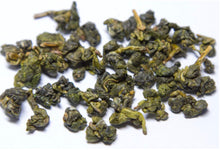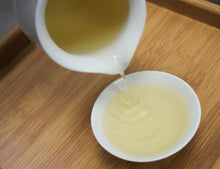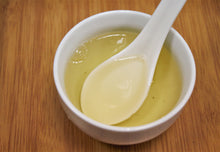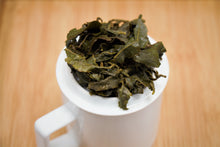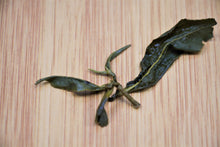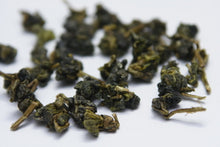
Ali Shan Cha is one of the famous and well-known Taiwan high mountain teas. It has a refreshing floral note with a hint of mild sweet undertone, with soft drinking sensation that lingers down the throat for a long time.
Some people like Ali San Cha as it is well balanced between Aroma and Flavor. The characteristic of Ali Shan Cha in term of flavor and aroma is similar to Dong Ding Oolong (Non-Fired Tea). The difference is Ali Shan Cha has more elegant flavor and smoother, softer drinking sensation and more long-lasting aftertaste.
For customer who is beginner in drinking Taiwan tea, we always suggest customer to start with Dong Ding Oolong and then move on to Ali Shan Cha.
It is a wonderful tea if you drink it anytime in a day. Its refreshing note reminds us of spring in highland.
1. Production Area

The tea garden gets very strong sunshine in the morning, but it is completely covered by fog in the afternoon.
The tea garden is located on the Ali mountain (Ali Shan) at Nantou County in Central Taiwan. Ali Shan is a very huge mountain that consist of many small mountains in a row. In general, the more number of tea garden exist at lower elevation and limited number exist at higher altitude. Both tea garden produce so-called Ali Shan Cha, yet quality is far different. Our Ali Shan Cha is carefully selected from the tea garden that is located at 1600m. The higher altitude gives significant benefit to the quality of tea as follow.
A: Huge temperature gap between day time and night time.
Higher up on the mountain, the sunshine is stronger. Likewise, we easily get sun-burned when we go to higher altitudes for trekking or sky diving. Tea receives a lot of sunshine in a day time and effectively carries out photosynthesis. Tea produces a lot of organic substances and stores them inside its leaf. At night, the tea leaves will consume the energy (organic substance) for metabolism. At high altitudes, the environment is very different and the temperature at night is very cold that tea can hardly proceed metabolism effectively. After all, most of the organic substances are accumulated inside tea leaves which makes the taste of tea becomes very thick.
B: Winter comes earlier and Spring comes later
In winter, the mineral absorbed by the tea trees from the ground will be accumulated inside the tree. It is because of the plant remains dormant during the very cold environment. This is the resting period of the plant. More mineral will be accumulated in the tree if the resting period is prolonged. The accumulated mineral will be distributed into the first up-coming tea leaves in spring. Mineral in tea is the primary element that contributes to the long lasting after taste. In a way, the longer the resting period of tea, the better the taste of tea.
At high mountain like Ali Shan, winter comes earlier while spring comes later as compared to lower altitude areas. As such, the tea trees has even longer resting period. Tea contains an extraordinary amount of minerals.
2. Cultivar and Plucking

Tea Garden of High Mountain Oolong
Our Ali Shan Cha is produced from Qing-Xin Oolong (青心烏龍種). This is the cultivars traditionally used for Dong Ding Oolong that gives a very refreshing taste. The taste of tea made of this particular cultivar is flowery and sharp, yet it gives long lasting taste that longer on our throat.
Tea grown at organic garden appears to be less active and less productivity as tea gets less nutrition and pesticide as compared to the ordinary tea garden. As the identical characteristics, tea leaf turns into yellow color and sweetness in flavor and taste is outstanding.
Plucking is carried out by hand. 3 to 4 leaves including a bud is carefully plucked. Plucking is carried out in Spring, Summer, Autumn and Winter. The best quality is produced either from Spring or Winter. At the lower elevation in Ali Shan, plucking is sometimes carried out more than 10 times. Less number of plucking allows longer resting period to the tree that enable tea to absorb more mineral.
Our Ali Shan Cha is grown at 1600m. Thanks to the limited number of plucking throughout the year, tea contains more amount of mineral that gives strong flavor.

High Mountain Tea Garden

This is the tea leaf that is attacked by green flies and turns into yellow in color
3. Processing
Sunshine Withering

Sunshine Withering of High Mountain Tea
After plucking, the tea leaves are spread over the ground under the natural sunshine. It is called Sunshine Withering. Usually clouded weather is ideal to grow this tea in order to avoid excess damage on tea leaves. If the sunny weather continues, a black cloth is used to cover the tea leaves to block out the harsh rays of sunshine. With sunshine withering, moisture inside the tea leaves gets evaporated and fermentation is moderately triggered. The tea leaves will gradually start releasing a refreshing aroma.
Indoor Withering
The method of fermentation for oolong tea is completely different from that of black tea. After the sunshine withering is completed, tea leaves are conveyed into the factory and spread over a sheet.


If the tea leaves are rich in moisture, they are spread into a thin layer in order to increase the evaporation process. The tea leaves are then tossed onto a bamboo tray. This agitation and tossing, causes friction and bruises the tea leaves which in turn causes the tea leaves to start fermentation.

Tea leaves are tossed onto a slanted bamboo tray in order to bruise them slightly.

Trays are then stored and fermentation of tea leaves will takes place.
The tray is then placed on a rack and these processes are repeated several times. This is called fermentation. Tea leaves gets oxidation mediated by the oxidative enzyme when the tea leaves get bruised.


Once entering the fermentation room, you might be surprised with its fragrance. You feel as if you are in a flower garden. Subsequently tea leaves are rotated in a bamboo drum. The tea leaves are lifted and dropped several times. Gradually the edge of tea leaves get damaged and further fermentation takes place. Tea leaves are again spread over the bamboo tray and the same process is repeated over and over again.
Once tea leaves get sufficient fermentation, it starts generating a flowery fragrance. Tea that is processed by a fine tea master is easily distinguishable. The original shape is maintained without any damage done to the tea leaves and only the edge of tea leaves are found to be red in color. This indicates that the tea leaves were successfully semi-fermented and the quality is far different from the tea leaves which have a reddish appearance at the center part of the leaf. Once the tea master finds that fermentation is sufficiently achieved, the tea is then sent for heat treatment in order to arrest further fermentation process. If this is not carried out swiftly, the tea leaves will keep on fermenting and it will finally turn into black tea.
The number of rotation and timing of fermentation is judged based on the moisture content, flavor and color. This decision requires top-notch experienced tea technicians which affects the quality of tea tremendously. All technicians follow the instruction of a tea master. In order to get good quality tea, we need to pick out an excellent tea master.
Rolling


At this stage, tea is fermented and gives an identical character of Dong Ding Oolong. However the tea leave have not been damaged or bruised except for its edges. Without physical damage on tea leaves, it is difficult to "brew". On the other hand, conducting the rolling process as black tea where tea leaves are twisted tautly under strong pressure, the tea leaves will be excessively damaged and will be astringent and harsh in taste. In addition, excessive damage of leaves expose constituents to the oxygen and cause unwanted oxidation that will also affect to the taste and flavor. Therefore the very unique rolling process called "Bag rolling" is used for oolong tea. Literary tea leaves are wrapped in a piece of cloth and rolled. Therefore, the tea leaves are twisted just right with the right amount of pressure applied.
While the tea leaves are still warm and soft, it is quickly wrapped in a cloth bag. About 10-20kg of tea leaf is wrapped and it is made into the size of about a basket ball. Then the end of cloth is mechanically twisted by machine in order to squeeze it into a very solid ball. Finally it becomes as solid as a stone ball and as a result the tea leaves are compressed very tightly.


Then, the cloth ball is clamped between disks at the top and bottom. The top disk does not move while the bottom disk rotate and tea gets further pressure through the motion. After the rolling process is conducted for a while, the bag is opened and the tea leaves are taken out and reheated again in a rotating drum. This is necessary as once the tea leaves cool down, it becomes crispy and easily crushed. This series of processes are repeated several times until it is well rolled.
The tea leaves are gradually tighten and become round in shape. High grade tea is usually very solid and it appears to be dark and shiny as the juice of the tea leaf is squeezed and hardens on the surface of the leaf.
The same sequence is repeated several times. The parameter is varied depending on the condition of leaf such as moisture content. It is important to feel the condition of tea leaf and apply the suitable method of process which is judge expertly by the tea master.
After this rolling process is completed, the tea leaves are dried and this will reduce the moisture content down to 5%.

Once tea leaves cool down, it becomes brittle. The tea leaves are then heated up inside a rotating drum to soften it again.

While these series of process are being carried out, the tea master is constantly monitoring attentively the condition of tea leaves in each step.

Nearly 10kg of tea leaves are packed in the cloth.
Ali Shan is the famous and well-known Taiwan high mountain.
Ali Shan Jin Xuan Oolong is made with a new variety of Jin Xuan cultivar grown in Ali Shan (Ali Mountain). Interestingly, it has a soft touch of milky note on palate with a refreshing floral note.
Some people might confused if natural tea leaf gives a milky note? It might sounds unusual and odd, but please give it a try first.
When brewing this tea with a proper water, you will immediately notice its unique flavor like fresh milk. You will never forget the taste once drinking it. This tea has many fans in Hojo.

Can brew 6 times?
You can use 5g (approximately 1 teaspoon) of tea leaves for capacity of 200cc and can make 6 brewing. If you want to enjoy during work, you can just put tea leaves into a mug or cup and pour in boiling hot water. You can refill boiling water again after drinking.
High Mountain Tea Standard
In Taiwan, high mountain tea refers the tea harvested from altitude more than 1000m. The standard high-mountain tea of Ali Shan is from 1500m altitude. The Li Shan tea which harvested in 2400m high-mountain is also good quality, but the price is extremely high. Ali Shan tea is recommended as it has a good balance between quality and price.
It is suitable for those who want to drink unique Taiwan high-mountain tea.
This Ali Shan Jin Xuan oolong is a non-baked tea. It has a standard scent and taste of ideal high-mountain tea. It is recommended for those who like refreshing tea.
High Mountain tea is the name given to oolong tea harvested at a tea plantation located at an altitude of about 1000m or higher. However, in reality, most of the oolong teas produced in Taiwan is distributed under the name of High Mountain tea regardless of altitude and location.
In reality, the taste and aroma differ depending on the mountain where the tea leaves are harvested. Among the many mountains, Ali Shan is a famous oolong tea producing area and is one of the alpine teas that we can confidently recommend.
If you actually go to Ali Shan, you will find it is a very deep mountain composed of many peaks. There are many tea gardens from the foot to the top of Ali Shan, the position of these tea gardens has a great influence to the quality of tea.
At Hojo, we want to provide the tea with a refreshing top note in flavor, so we purchase the un-blended Ali Shan tea from tea garden at 1500m altitude.
Furthermore, this tea is made from a different variety called Jin Xuan from the same area of Ali Shan tea. Our standard Ali Shan tea is made from Qing Xin oolong cultivar. Ali Shan Jin Xuan has a totally different scent from the conventional Ali Shan tea.
In addition, this tea is a refreshing type of oolong tea that is not baked. So, the quality emphasizes a more rounded taste.
History and Culture
Ali Shan also known as the mountain of worship, there are many local tourists visiting Ali Shan.
Ali Shan is also known as Taiwan's only cedar producing area, and it is also known that a trolley train was built when Taiwan was under Japanese rule.
The tea cultivated in Ali Shan tea was planted by immigrants from Fujian province in the olden days, but with the recent epidemic of high-mountain tea, the tea plantation is expanding to higher altitudes in other mountains.
Ali Shan tea in Taiwan is positioned similar to Sencha in Japan, and its character is neither too strong nor too weak. It is a well-balanced tea that you will not get tired of even if you continue to drink it every day.
The tea leaf called Jin Xuan Oolong is a new variety of oolong tea, which was developed in recent years by the efforts of the Tea Leaf Laboratory. It has a unique aroma, a soft and sweet note like milk, and a silky smooth drinking sensation. The conventional oolong tea is made from Qing Xin oolong. I think it is better to think of them as completely different teas because they have completely different properties even though they are made in the same mountain.

1. Production Area

The tea garden gets very strong sunshine in the morning, but it is completely covered by fog in the afternoon. The fog allows the sunlight to be neither too strong nor too weak, giving the best sunlight to produce high quality tea.
The tea garden is located in Nantou County, Taiwan, at an altitude of 1000m or more above sea level. Areas over 1000m are bright only in the morning and are covered with fog over a very wide area from around the afternoon to the evening. Since this condition continues almost everyday, the tea leaves are exposed to sufficient sunlight only in the morning.
Good quality oolong tea has a smooth texture and a mild sweetness. The true identity of this taste is an amino acid called theanine. Theanine is abundant in young tea buds and is bio-synthesized into catechins and other polyphenols when tea leaves absorb sunlight.
Tea leaves that are blocked from sunlight by fog have a high proportion of theanine because it is difficult to convert theanine to polyphenols.
2. Cultivar and Plucking
The plucking standard of oolong tea is different from green tea. If tea leaves are harvested too early like 1 bud with 1 or 2 leaves, the umami taste from theanine is rich, but the polyphenols that contribute to the flavor is less. So, in making oolong tea, it is important to pluck the right number of tea leaves like 1 bud with 3-4 leaves, so that tea leaves contain a balance of both theanine and polyphenols. In addition, the tea quality is not the same at all timing. Hojo only buys tea harvested in March. The later the plucking time, the lower the grade, tea taste becomes more astringent and less sweet.
This tea is made from a variety called Jin Xuan Oolong. For ordinary Ali Shan tea, it is made from a variety called Qing Xin Oolong Tea, which is characterized by a refreshing and fruity scent. On the other hand, the Jin Xuan Oolong, is the variety developed in recent years, and the flavor is slightly different from Qing Xin oolong. Many customers think of fresh milk when they drink it, and Jin Xuan's unique characteristic is its silky soft drinking sensation with a lingering fruity note down the throat.

Jin Xuan Oolong - the tea leaf is slight glossy with broader surface

Qing Xin Oolong - the shape of tea leaf is slimmer and longer
3. Processing
Sunshine Withering

Sunshine Withering of High Mountain Tea
After plucking, the tea leaves are spread over the ground under the natural sunshine. It is called Sunshine Withering. Usually clouded weather is ideal to grow this tea in order to avoid excess damage on tea leaves. If the sunny weather continues, a black cloth is used to cover the tea leaves to block out the harsh rays of sunshine. With sunshine withering, moisture inside the tea leaves gets evaporated and fermentation is moderately triggered. The tea leaves will gradually start releasing a refreshing aroma.
Indoor Withering
The method of fermentation for oolong tea is completely different from that of black tea. After the sunshine withering is completed, tea leaves are conveyed into the factory and spread over a sheet.


If the tea leaves are rich in moisture, they are spread into a thin layer in order to increase the evaporation process. The tea leaves are then tossed onto a bamboo tray. This agitation and tossing, causes friction and bruises the tea leaves which in turn causes the tea leaves to start fermentation.

Tea leaves are tossed onto a slanted bamboo tray in order to bruise them slightly.

Trays are then stored and fermentation of tea leaves will takes place.
The tray is then placed on a rack and these processes are repeated several times. This is called fermentation. Tea leaves gets oxidation mediated by the oxidative enzyme when the tea leaves get bruised.


Once entering the fermentation room, you might be surprised with its fragrance. You feel as if you are in a flower garden. Subsequently tea leaves are rotated in a bamboo drum. The tea leaves are lifted and dropped several times. Gradually the edge of tea leaves get damaged and further fermentation takes place. Tea leaves are again spread over the bamboo tray and the same process is repeated over and over again.
Once tea leaves get sufficient fermentation, it starts generating a flowery fragrance. Tea that is processed by a fine tea master is easily distinguishable. The original shape is maintained without any damage done to the tea leaves and only the edge of tea leaves are found to be red in color. This indicates that the tea leaves were successfully semi-fermented and the quality is far different from the tea leaves which have a reddish appearance at the center part of the leaf. Once the tea master finds that fermentation is sufficiently achieved, the tea is then sent for heat treatment in order to arrest further fermentation process. If this is not carried out swiftly, the tea leaves will keep on fermenting and it will finally turn into black tea.
The number of rotation and timing of fermentation is judged based on the moisture content, flavor and color. This decision requires top-notch experienced tea technicians which affects the quality of tea tremendously. All technicians follow the instruction of a tea master. In order to get good quality tea, we need to pick out an excellent tea master.
Rolling


At this stage, tea is fermented and gives an identical character of High Mountain Oolong. However the tea leave have not been damaged or bruised except for its edges. Without physical damage on tea leaves, it is difficult to "brew". On the other hand, conducting the rolling process as black tea where tea leaves are twisted tautly under strong pressure, the tea leaves will be excessively damaged and will be astringent and harsh in taste. In addition, excessive damage of leaves expose constituents to the oxygen and cause unwanted oxidation that will also affect to the taste and flavor. Therefore the very unique rolling process called "Bag rolling" is used for oolong tea. Literary tea leaves are wrapped in a piece of cloth and rolled. Therefore, the tea leaves are twisted just right with the right amount of pressure applied.
While the tea leaves are still warm and soft, it is quickly wrapped in a cloth bag. About 10-20kg of tea leaf is wrapped and it is made into the size of about a basket ball. Then the end of cloth is mechanically twisted by machine in order to squeeze it into a very solid ball. Finally it becomes as solid as a stone ball and as a result the tea leaves are compressed very tightly.


Then, the cloth ball is clamped between disks at the top and bottom. The top disk does not move while the bottom disk rotate and tea gets further pressure through the motion. After the rolling process is conducted for a while, the bag is opened and the tea leaves are taken out and reheated again in a rotating drum. This is necessary as once the tea leaves cool down, it becomes crispy and easily crushed. This series of processes are repeated several times until it is well rolled.
The tea leaves are gradually tighten and become round in shape. High grade tea is usually very solid and it appears to be dark and shiny as the juice of the tea leaf is squeezed and hardens on the surface of the leaf.
The same sequence is repeated several times. The parameter is varied depending on the condition of leaf such as moisture content. It is important to feel the condition of tea leaf and apply the suitable method of process which is judge expertly by the tea master.
After this rolling process is completed, the tea leaves are dried and this will reduce the moisture content down to 5%.

Once tea leaves cool down, it becomes brittle. The tea leaves are then heated up inside a rotating drum to soften it again.

While these series of process are being carried out, the tea master is constantly monitoring attentively the condition of tea leaves in each step.

Nearly 10kg of tea leaves are packed in the cloth.
Crude Tea and Secondary Drying
The tea leaves that have been rolled and dried become "crude tea" in Japanese, it is called Aracha in Japan. It has a refreshing green scent and is characterized by a very refreshing taste. Aracha is a favorite drink in Taiwan. In fact, Aracha has a very refreshing finish, as if the scent of the tea plantation is trapped as it is.
However, this refreshing flavor will not last long in the state of crude tea. In addition, depending on the type of tea, a process called secondary drying is required. For example, the famous Dong Ding Oolong Tea brings out a unique aroma and taste by drying crude tea with heat. By secondary drying, the substances are stabilized and the tea will last longer. However, the need for secondary drying depends on the tea and the interest of the buyer.
Water to Use
We recommend tap water because it is a common source of water. Please use water purifier with an activated carbon filter to remove chlorine in the water. If no filter and tap water is used, boil for 3-5 minutes to remove chlorine. However, even if it boils, chlorine cannot be completely removed. The aroma components of tea and chlorine will react together and you will not be able to enjoy the fullness in aroma and taste. In addition, chlorine is added to kill microorganisms. It kills not only health-harmful microorganisms, but also the good bacteria that live in our intestines. In addition, various harmful effects have been reported at the cellular level, which can be a cause of allergies.Amount of Tea Leaves






